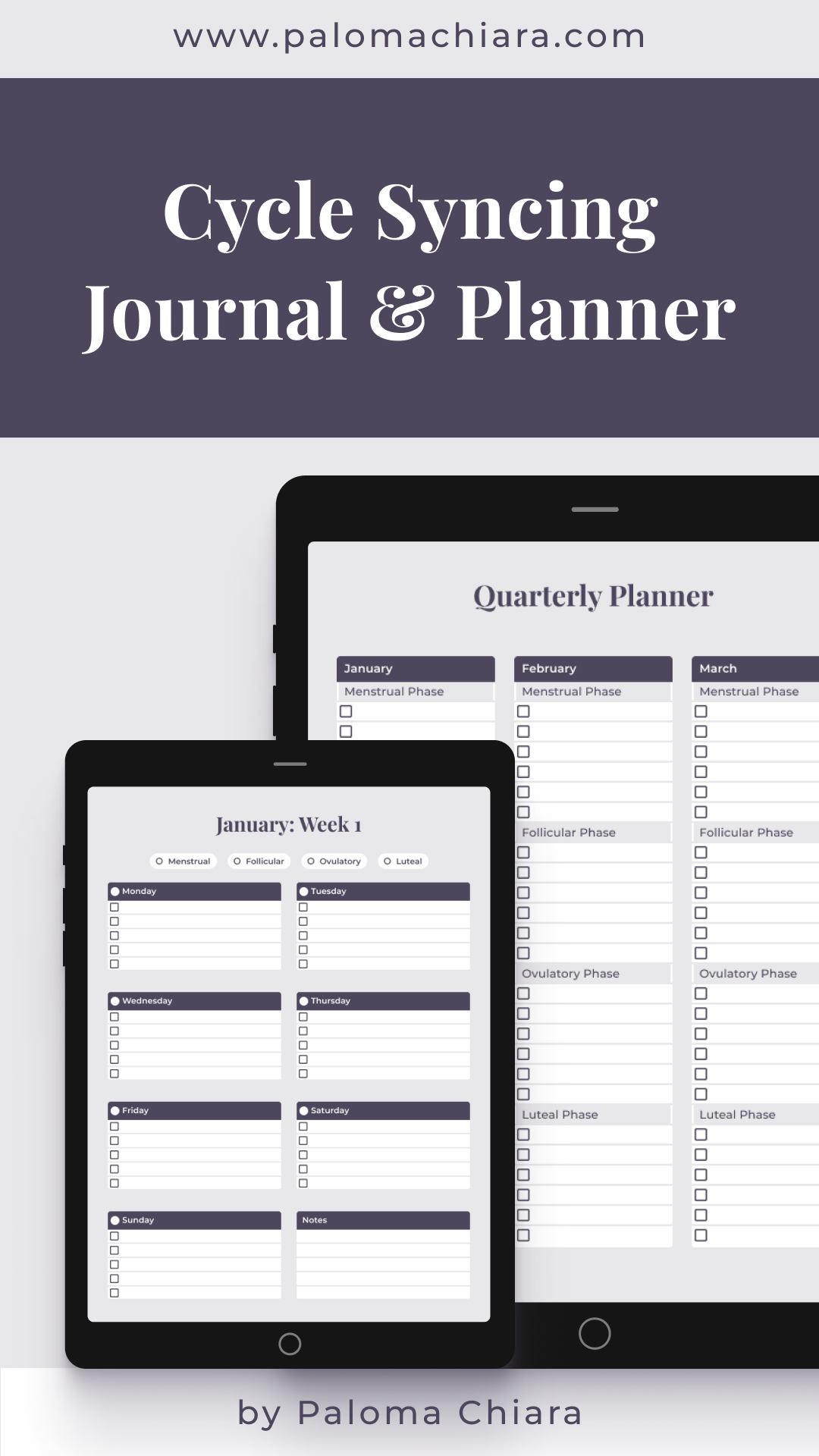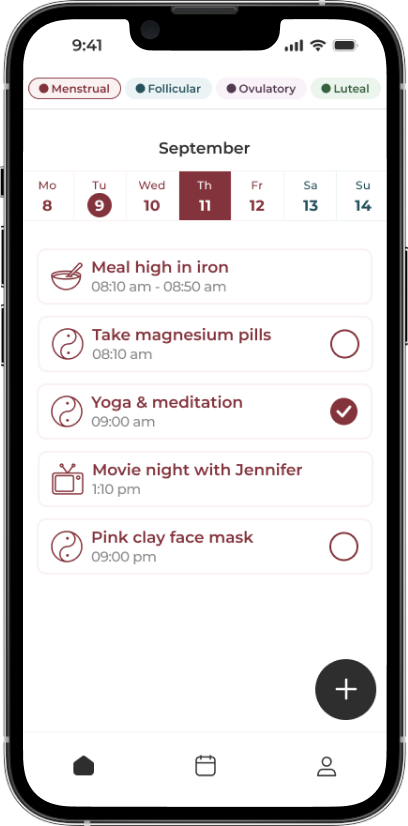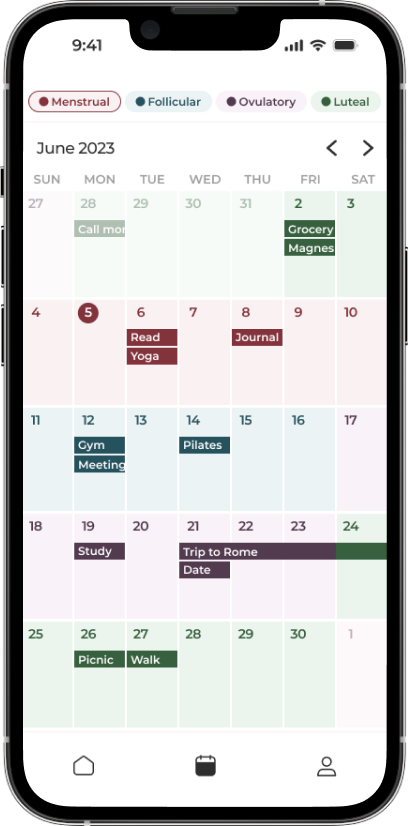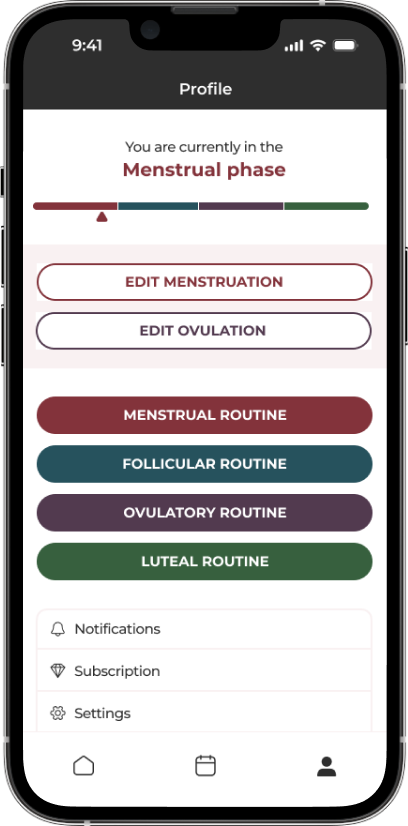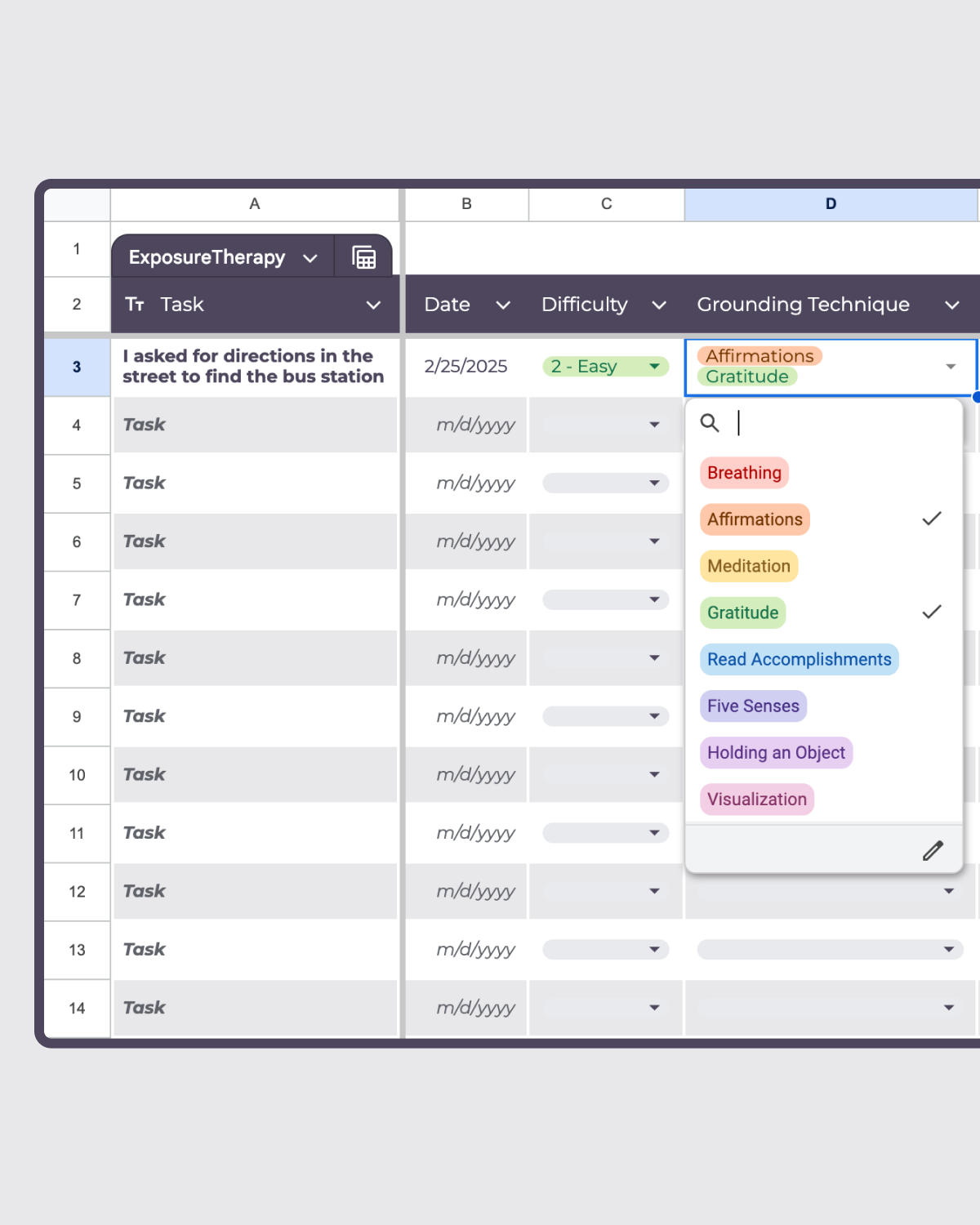
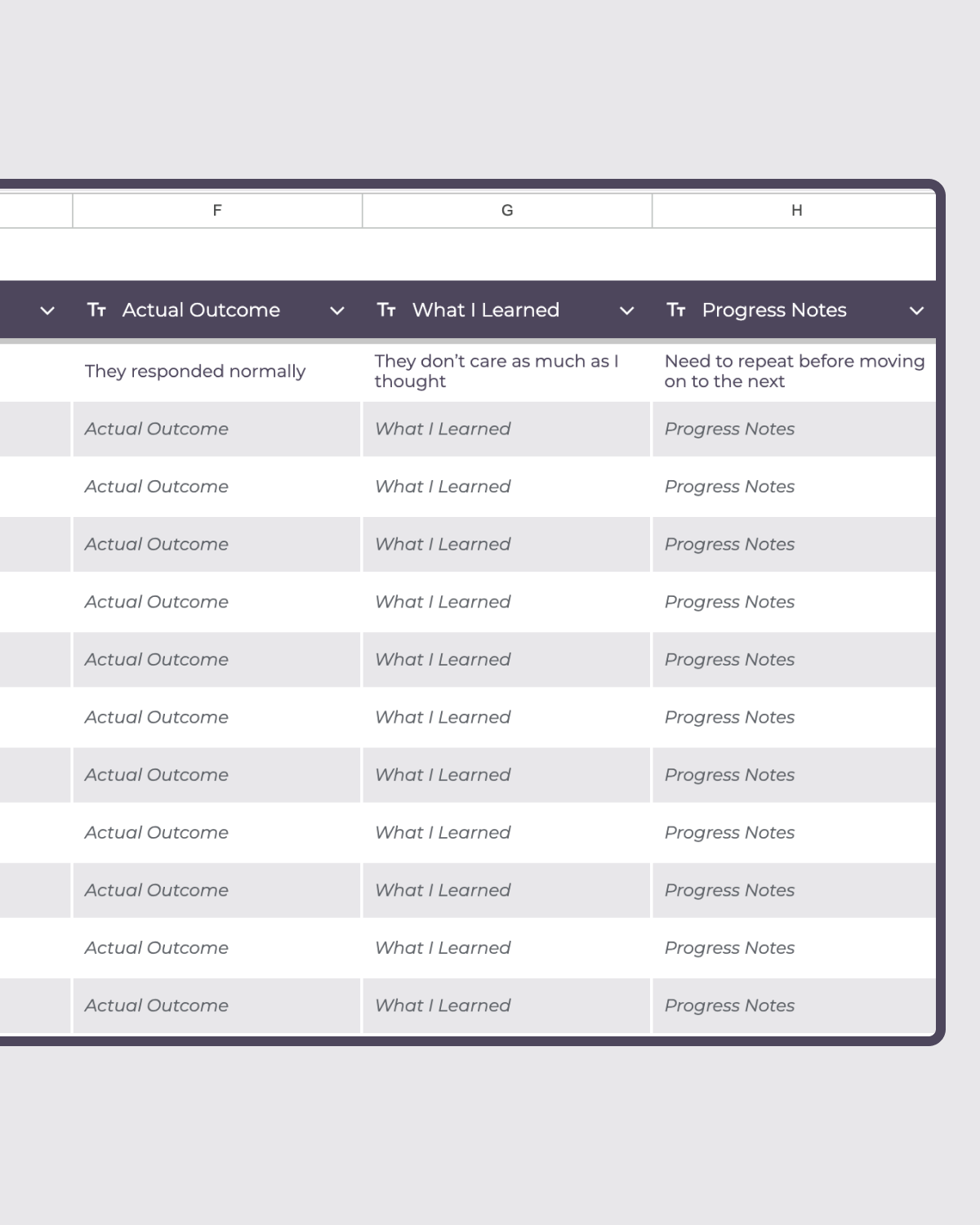
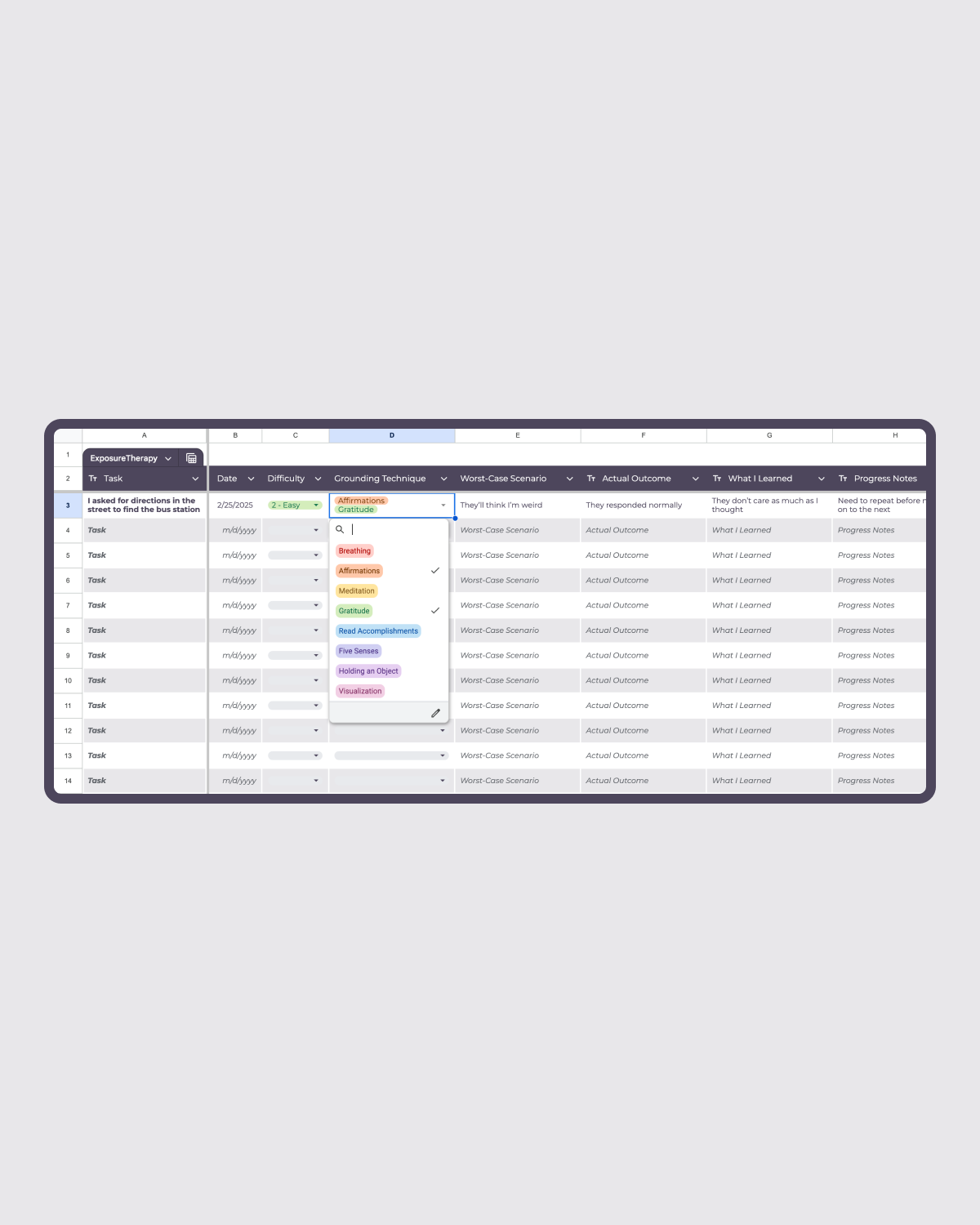
Exposure Therapy Google Sheets Template
2$
This Exposure Therapy Tracker allows you to confront anxieties and fears in manageable steps with a structured approach by creating personalized hierarchies and tracking your progress through each challenge.
The tracker features columns including task description, completion date, and a dropdown menu to rate difficulty levels. Select from pre-defined grounding techniques like affirmations or breathing exercises to use during exposures. Document your worst-case scenario fears, then record the actual outcomes to challenge distorted thinking. Dedicated spaces for capturing learnings to help you build self-awareness to overcoming anxiety.
-
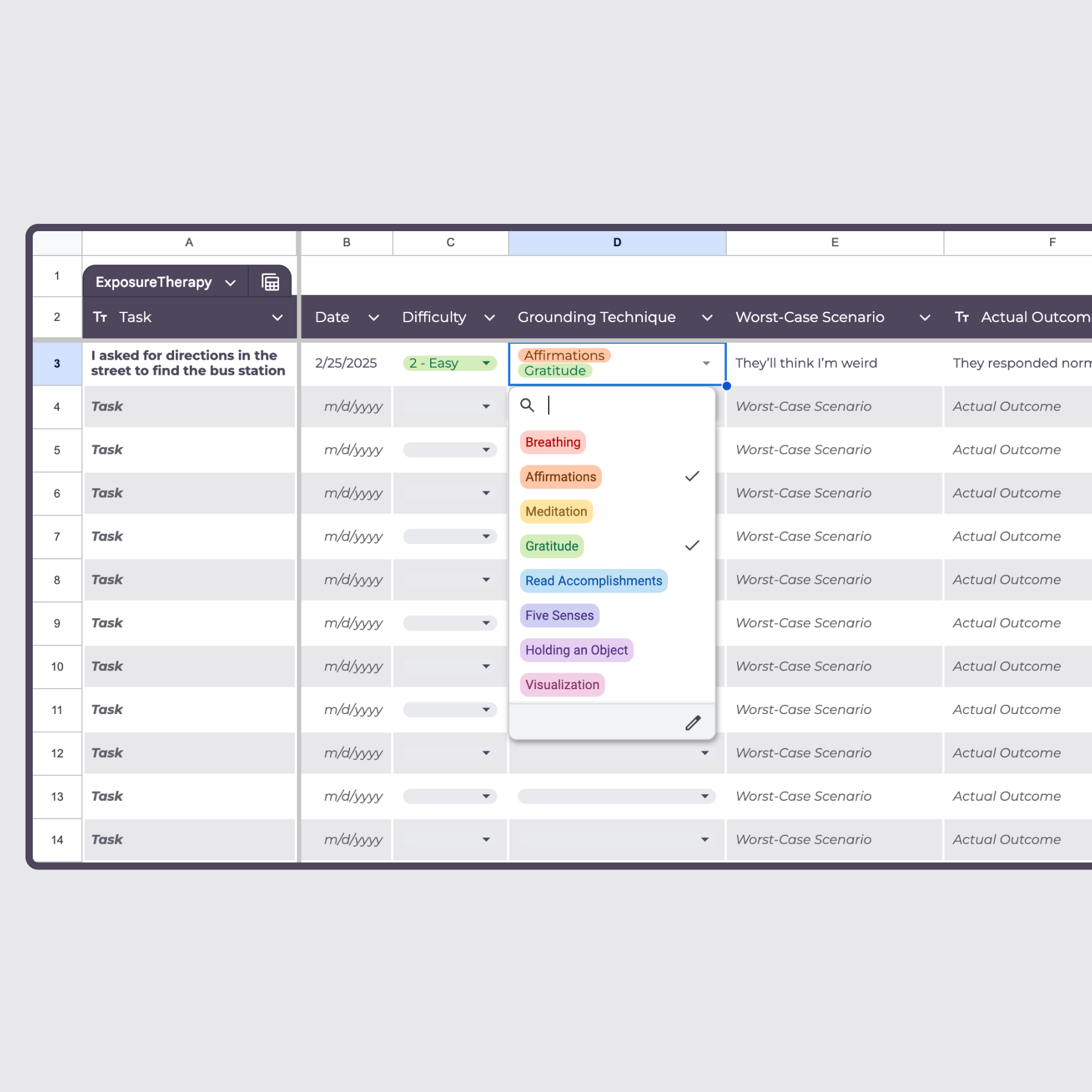
Exposure Therapy Tracker
In this spreadsheet, you will find the columns:
- Task
- Date
- Difficulty Level (Dropdown)
- Grounding Techniques (Dropdown)
- Worst-Case Scenario
- Actual Outcome
- What I Learned
- Progress Notes
-
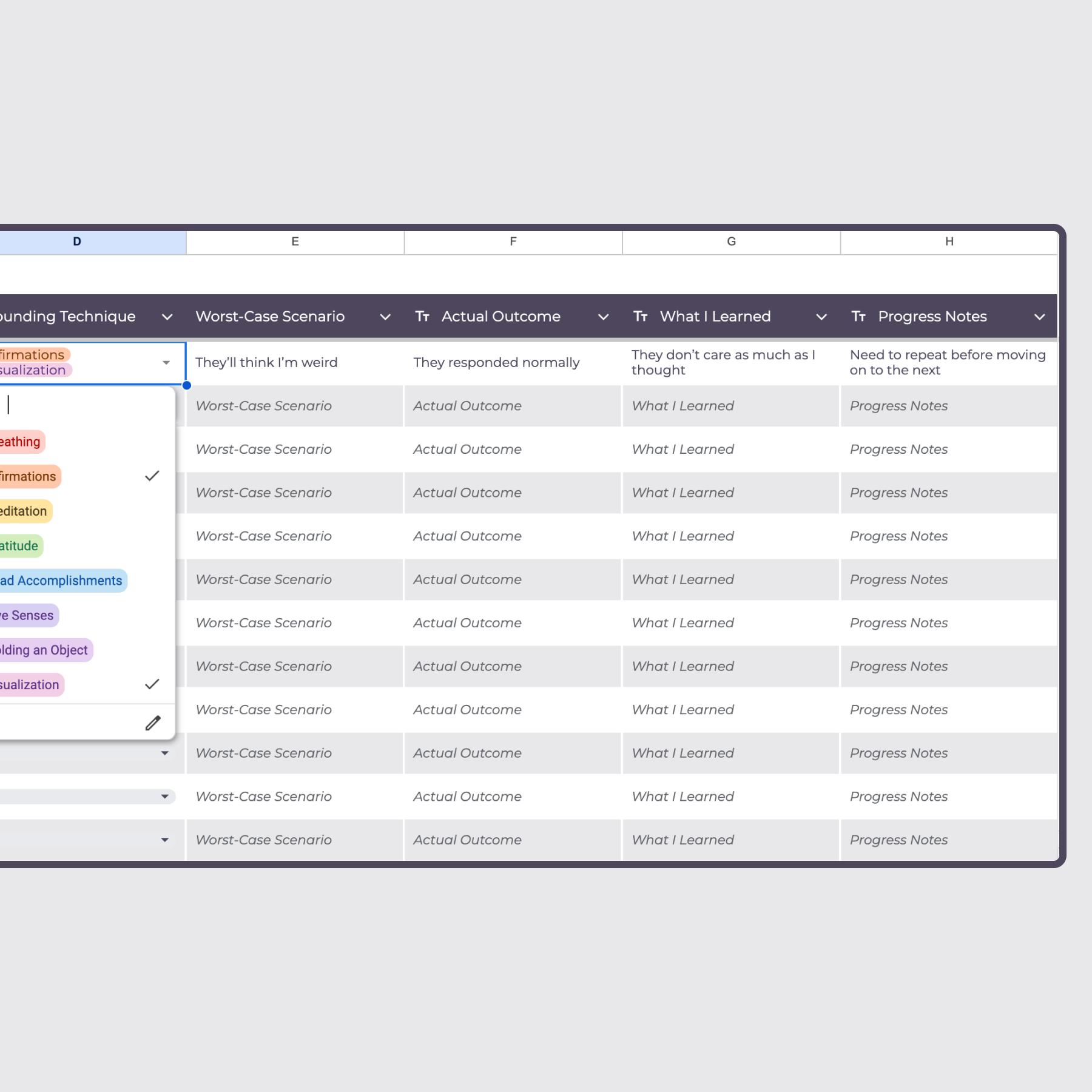
Google Sheets & Excel Spreadsheet
Buy nowAfter purchase, you will receive a link to the original Google Sheets document, from which you will be able to make a copy from.
This customizable Google Sheets template helps you create personalized hierarchies, set realistic goals, and track your progress through each challenge. With built-in reflection prompts, you’ll identify patterns and celebrate victories along your journey.
- Includes 1 sheet, 1 table
- Can be exported into an Excel sheet
Self-Improvement for High Achievers Group on Telegram
Get daily insights, support, and discussions to improve your leadership skills, mindset, work/life balance, time and energy management, as well as overcoming perfectionism, self-doubt, limiting beliefs, and more...
Join groupFAQs About Exposure Therapy
What Is Exposure Therapy (or Systematic Desensitization)?
Exposure therapy is a behavioral therapy technique that helps individuals overcome fears, anxieties, or phobias by gradually exposing them to the source of their distress in a controlled, safe environment. Systematic desensitization, a specific form of exposure therapy, combines exposure with relaxation techniques to reduce anxiety responses. The core principle is that repeated exposure to feared situations, objects, or thoughts without experiencing harm leads to decreased anxiety over time as the brain “learns” that these triggers aren’t actually dangerous.
Why Does Exposure Therapy Work?
Exposure therapy works through several psychological and neurobiological mechanisms:
- Habituation: With repeated or prolonged exposure to feared stimuli, your anxiety naturally decreases as your nervous system adapts. What initially triggered intense fear becomes more tolerable over time.
- Extinction learning: Your brain forms new neural pathways that compete with and eventually override the fear associations. You learn that what you fear doesn’t actually lead to the dreaded outcome.
- Emotional processing: Exposure allows you to fully process feared situations rather than avoiding them, helping your brain update its threat assessment with more accurate information.
- Self-efficacy: Successfully facing fears builds confidence in your ability to cope with anxiety, changing how you view both yourself and the feared situations.
- Cognitive restructuring: Through direct experience, you gather evidence that challenges catastrophic thinking patterns and reinforces more realistic beliefs.
Research consistently shows that exposure therapy is one of the most effective treatments for anxiety disorders, with success rates between 60-90% for specific phobias and comparable effectiveness for other anxiety conditions when properly implemented.
What Can I Use Exposure Therapy For?
Exposure therapy is highly versatile and can be applied to a wide range of anxiety-related concerns. Here are the main categories and specific examples of tasks you might track in your exposure hierarchy:
Social Anxiety
- Making a phone call to schedule an appointment
- Asking a question in a meeting or class
- Initiating conversation with a stranger
- Giving a short presentation to a small group
- Eating in public restaurants
- Expressing disagreement in a group setting
- Making eye contact during conversations
- Attending social gatherings without a companion
Specific Phobias
- Animals: Looking at pictures of feared animals, watching videos, viewing from a distance, being in the same room
- Medical/Dental: Sitting in a waiting room, examining medical instruments, discussing procedures
- Flying: Visiting an airport, watching planes take off, sitting in a stationary plane
OCD & Intrusive Thoughts
- Touching “contaminated” objects without washing
- Leaving home without checking locks multiple times
- Deliberately writing down feared thoughts
- Not performing ritualistic behaviors when anxiety arises
- Leaving items slightly disorganized
- Delaying compulsive behaviors for increasing periods
Performance Anxiety
- Practicing skills while someone observes
- Recording yourself performing and watching the recording
- Performing for one supportive person, then gradually larger groups
- Deliberately making small mistakes during practice
- Competing in low-stakes situations before higher-stakes ones
Remember to build your hierarchy starting with tasks that cause mild anxiety (rated 3-4 out of 10) and gradually work toward more challenging situations (8-9 out of 10). The most effective exposures are those that directly target your specific fears while being achievable with sufficient effort.
What Are Grounding Techniques?
Grounding techniques are practical coping strategies that help anchor you to the present moment when feeling overwhelmed by anxiety, stress, or traumatic memories. These techniques redirect attention away from distressing thoughts and back to the present environment. Common grounding methods include deep breathing exercises, the 5-4-3-2-1 sensory awareness technique (identifying things you can see, touch, hear, smell, and taste), physical grounding (feeling your feet on the floor), repeating affirmations, and mindfulness practices. They’re valuable tools during exposure exercises to manage heightened anxiety.
Can I Do Exposure Therapy on My Own?
While professional guidance is ideal, self-directed exposure therapy can be effective for milder anxieties and phobias. Consider these factors before attempting it yourself:
- Start with lower-level anxieties rather than severe phobias or trauma
- Have a clear, graduated hierarchy of fears from least to most distressing
- Establish safety parameters and have support available if needed
- Use structured tools like the tracker to monitor progress
- Know when to seek professional help if symptoms worsen or you feel stuck
For moderate to severe anxiety disorders, PTSD, or complex phobias, working with a trained therapist is strongly recommended, especially at the beginning stages.
How to Correctly Do Exposure Therapy?
Effective exposure therapy follows these key principles:
- Assessment and planning: Identify specific fears and create a hierarchy from least to most anxiety-provoking
- Gradual progression: Start with situations that cause mild anxiety and gradually work up the hierarchy
- Extended exposure: Stay in each situation long enough for anxiety to naturally decrease (typically 30-60 minutes)
- Regular practice: Consistency is essential—aim for multiple weekly sessions
- Prevent avoidance: Resist urges to use safety behaviors or escape when anxiety rises
- Track progress: Document subjective anxiety levels before, during, and after exposures
- Challenge thoughts: Identify and reframe unhelpful thinking patterns related to fears
- Persistence: Continue exposures until the situation no longer provokes significant anxiety
The most common mistake is moving too quickly up the hierarchy or not spending enough time in each exposure situation.
Does Anxiety Get Worse Before It Gets Better?
Yes, temporary increases in anxiety are a normal part of the exposure therapy process. Many people experience a phenomenon called “habituation,” where anxiety initially spikes when confronting a feared situation but gradually subsides with continued exposure. This pattern may repeat over several sessions before noticeably decreasing.
Some may also experience an “extinction burst,” where anxiety symptoms temporarily intensify as the brain makes a final effort to maintain the fear response. This can feel discouraging but is actually a sign that change is occurring. Consistent practice through this difficult period typically leads to significant improvement afterward.
Remember that short-term discomfort is part of the process that leads to long-term relief.
When Is Exposure Therapy Not Recommended?
Exposure therapy may not be appropriate in these situations:
- Acute crisis: Individuals in immediate psychological crisis need stabilization first
- Severe depression: When depression symptoms interfere with motivation or ability to engage in exercises
- Active substance abuse: Substances may interfere with learning processes essential for exposure benefits
- Certain medical conditions: People with conditions where anxiety could pose health risks (e.g., severe cardiac issues)
- Without proper support: Those without adequate coping skills or support systems
- Complex trauma: For some with complex trauma, other therapeutic approaches may be needed initially
- Lack of voluntary consent: The person must be willing to participate, not coerced
- Psychosis: Active psychotic symptoms generally contraindicate exposure therapy
If you have concerns about whether exposure therapy is right for you, consulting with a mental health professional for a personalized assessment is recommended.
Disclaimer
- Not Medical Advice: This template is provided for informational and educational purposes only. It is not intended to diagnose, treat, cure, or prevent any mental health condition or substitute for professional advice from a licensed therapist, counselor, or healthcare provider. If you are experiencing mental health challenges, please consult a qualified professional before using this template.
- Use at Your Own Risk: By using this template, you acknowledge that exposure therapy involves inherent risks and may cause emotional distress or discomfort. You agree that you are using this template voluntarily and assume full responsibility for any outcomes resulting from its use. The creator of this template is not liable for any physical, emotional, or psychological harm caused by its use.
- No Guarantees: This template is designed as a general resource and does not guarantee specific results. Individual experiences with exposure therapy vary widely based on personal circumstances. The creator makes no promises regarding the effectiveness of this template in achieving your goals.
- Release of Liability: By purchasing or using this template, you agree to release the creator from any and all liability related to your use of the product. You understand that exposure therapy should ideally be conducted under the supervision of a licensed professional, and using this template without such supervision is at your own discretion and risk.
- Consult a Professional: This template is not a substitute for professional therapy or guidance. If you are unsure about how to proceed with exposure therapy or if you experience significant distress while using this template, stop immediately and consult a licensed therapist or healthcare provider.
- Terms of Use: By using this template, you agree to adhere to the guidelines provided and understand that misuse of the product may result in unintended consequences. The creator reserves the right to update or modify these disclaimers at any time without prior notice.
Hire me as your life coach
Let's start
The App Made To Sync Your Lifestyle to Your Menstrual Cycle.
A solution for women who are looking to keep track of what they sync to their cycles, such as fitness, diet, etc. by adding it to a calendar that also predict their phases.
Learn more

